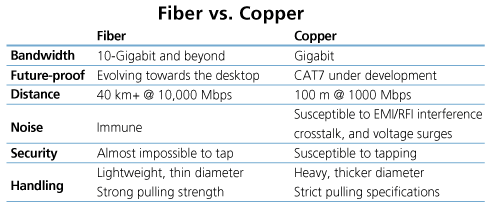
Fiber Modems Versus Dial Up Lease Line Copper Modems
Call us for Pre-sales and discount pricing
on Fiber Multi Mode Modems or 2 Wire
Dial Up - 2 Wire 4 Wire Lease Line Modems
301-924-7400
Support
Fiber versus copper.
When planning a new or upgraded cabling infrastructure, you have two basic
choices: fiber or copper. Both offer superior data transmission. The decision on
which one to use may be difficult. It will often depend on your current network,
your future networking needs, and your particular application, including
bandwidth, distances, environment, cost, and more. In some cases, copper may be
a better choice; in other situations, fiber offers advantages.
Although copper cable is currently more popular and much more predominant in structured cabling systems and networks, fiber is quickly gaining fans.
Fiber optic cable is becoming one of the fastest-growing transmission mediums for both new cabling installations and upgrades, including backbone, horizontal, and even desktop applications. Fiber optic cable is favored for applications that need high bandwidth, long distances, and complete immunity to electrical interference. It’s ideal for high data-rate systems such as Gigabit Ethernet, FDDI, multimedia, ATM, SONET, Fibre Channel, or any other network that requires the transfer of large, bandwidth-consuming data files, particularly over long distances. A common application for fiber optic cable is as a network backbone, where huge amounts of data are transmitted. To help you decide if fiber is right for your new network or if you want to migrate to fiber, take a look at the following:

The advantages of fiber.
Greater bandwidth—Because fiber provides far greater
bandwidth than copper and has proven performance at rates up to 10 Gbps, it
gives network designers future-proofing capabilities as network speeds and
requirements increase. Also, fiber optic cable can carry more information with
greater fidelity than copper wire. That’s why the telephone networks use fiber,
and many CATV companies are converting to fiber.
Low attenuation and greater distance—Because the fiber optic signal is made of light, very little signal loss occurs during transmission so data can move at higher speeds and greater distances. Fiber does not have the 100-meter (304.8-ft.) distance limitation of unshielded twisted-pair copper (without a booster). Fiber distances can range from 300 meters to 40 kilometers, depending on the style of cable, wavelength, and network. (Fiber distances are typically measured in metric units.) Because fiber signals need less boosting than copper ones do, the cable performs better
Fiber networks also enable you to put all your electronics and hardware in one central location, instead of having wiring closets with equipment throughout the building.
Security—Your data is safe with fiber cable. It does not radiate signals and is extremely difficult to tap. If the cable is tapped, it’s very easy to monitor because the cable leaks light, causing the entire system to fail. If an attempt is made to break the security of your fiber system, you’ll know it.
Immunity and reliability—Fiber provides extremely reliable data transmission. It’s completely immune to many environmental factors that affect copper cable. The fiber is made of glass, which is an insulator, so no electric current can flow through. It is immune to electromagnetic interference and radio-frequency interference (EMI/RFI), crosstalk, impedance problems, and more. You can run fiber cable next to industrial equipment without worry. Fiber is also less susceptible to temperature fluctuations than copper is and can be submerged in water.
Design—Fiber is lightweight, thin, and more durable than copper cable. And, contrary to what you might think, fiber optic cable has pulling specifications that are up to ten times greater than copper cable’s. Its small size makes it easier to handle, and it takes up much less space in cabling ducts. Although fiber is still more difficult to terminate than copper is, advancements in connectors are making temination easier. In addition, fiber is actually easier to test than copper cable.
Migration—The proliferation and lower costs of media converters are making copper to fiber migration much easier. The converters provide seamless links and enable the use of existing hardware. Fiber can be incorporated into networks in planned upgrades.
Standards—New TIA/EIA standards are bringing fiber closer to the desktop. TIA/EIA-785, ratified in 2001, provides a cost-effective migration path from 10-Mbps Ethernet to 100-Mbps Fast Ethernet over fiber (100BASE-SX). A recent addendum to the standard eliminates limitations in transceiver designs. In addition, in June 2002, the IEEE approved a 10-Gigabit Ethernet standard.
Costs—The cost for fiber cable, components, and hardware is steadily decreasing. Installation costs for fiber are higher than copper because of the skill needed for terminations. Overall, fiber is more expensive than copper in the short run, but it may actually be less expensive in the long run. Fiber typically costs less to maintain, has much less downtime, and requires less networking hardware. And fiber eliminates the need to recable for higher network performance.
- Purchase orders accepted on Paradyne equipment
- Contract Buying and Volume Discounts available !!
- Please contact us 301-924-7400